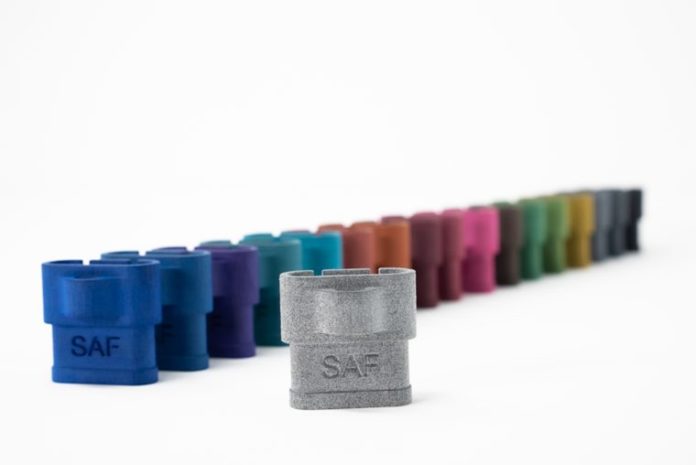Beyond the creation of a reference architecture, this is about establishing a unique, sustainable solution for cleaning, chemical smoothing and dyeing.
In the additive manufacturing industry, architecture is often relegated to the level of “mere artistic production”. As a matter of fact, we have been covering the use of AM in this field of activity for several years now, and there is a very short list of companies that dare to address the industrialization process of AM in the field.
This is about to change as Stratasys and DyeMansion ambition to create the first reference architecture for production scale additive manufacturing. The announcement follows Stratasys’ big reveal of three new 3D printers as well as five new postprocessing systems from DyeMansion.
The reference architecture will consist in achieving reproducible and quality results in mass production of 3D printed end-use parts, with prices that are competitive with conventional manufacturing processes.
The technologies at the heart of this project will be the Stratasys H350™ 3D printer and the DyeMansion Print-to-Product workflow.
TheH350™ 3D printer was part of the big reveal last week. Based on a new brand technology called SAF™, the new machine is a powder-bed system that aims to provide manufacturers with production consistency, a competitive and predictable cost per part, and complete production control for volumes of thousands of parts.
The DyeMansion Print-to-Product workflow seems to be a great fit for the new 3D printer to achieve several postprocessing tasks such as cleaning, surfacing, and coloring parts.
“Together with DyeMansion, we’re giving our customers a comprehensive, proven additive manufacturing process tailored to our H350 3D printer. This enables our customers to easily move from powder to consistent, quality-finished parts at scale. The alliance will help accelerate the adoption of SAF technology for end-use parts production,” said Patrick Carey, senior vice president, Americas Products and Solutions, Stratasys.
According to Stratasys experience with the DyeMansion solution, postprocessing tasks achieved with PA11 polymer 3D printed parts show promising results. However, it should be noted that operators can have two options when it comes to finishes: an aesthetic semi-gloss finish for a homogeneous scratch resistant surface, or a more functional finish delivering for complete sealed and washable surfaces.
“We are extremely happy that Stratasys has partnered with us to create this reference architecture. Together we are able to deliver best-in-class solutions to our customers and demonstrate the value of combining their new SAF technology with our solutions to enable high-value and high-volume applications across various industries. The future of industrial 3D printing starts here. We are very excited about our partnership and are even more excited to see where our partnership will take us,” says Felix Ewald, Co-Founder & CEO of DyeMansion.
This alliance ambitions to go beyond the creation of a reference architecture, and to establish a unique, sustainable solution for cleaning, chemical smoothing and dyeing.
The SAF technology is still new on the market, therefore we haven’t seen yet a wide range of applications that can prove its capabilities. However, given Stratasys expertise in additive manufacturing of repeatable parts produced with several technologies, and DyeMansion’s proven applications across the eyewear, automotive interior or spare parts, and medical devices and orthotics fields, I think this alliance for architecture is up to something that is worth following.
Remember, you can post job opportunities in the AM Industry on 3D ADEPT Media free of charge or look for a job via our job board. Make sure to follow us on our social networks and subscribe to our weekly newsletter : Facebook, Twitter, LinkedIn & Instagram ! If you want to be featured in the next issue of our digital magazine or if you hear a story that needs to be heard, make sure you send it to contact@3dadept.com



